#Civil War Battles
Explore tagged Tumblr posts
Text
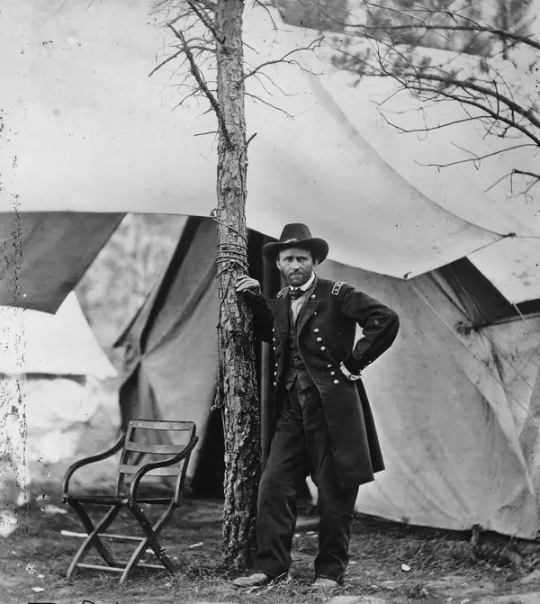
After that terrible Sunday at Shiloh, I started out to find [General] Grant and see how we were to get across the river. It was pouring rain and pitch dark, there was considerable confusion, and the only thing just then possible as it seemed to me, was to put the river between us and the enemy and recuperate. Full of only this idea, I ploughed around in the mud until at last I found him standing backed up against a wet tree, his hat well slouched down and coat pulled up around his ears, an old tin lantern in his hand, the rain pelting on us both, and the inevitable cigar glowing between his teeth, having retired, evidently, for the night. Some wise and sudden instinct impelled me to a more cautious and less impulsive proposition than at first intended, and I opened up with, "Well Grant, we've had the devil's own day, haven't we?" "Yes," he said, with a short, sharp puff of the cigar; "lick 'em tomorrow, though."
-- General William Tecumseh Sherman, on General Ulysses S. Grant after the first day of the Civil War's Battle of Shiloh in 1862, as told to the Washington Post (published May 17, 1891).
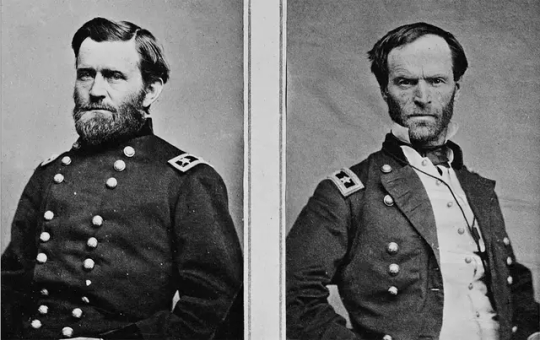
#History#Civil War#Ulysses S. Grant#William Tecumseh Sherman#General Grant#General Sherman#Battle of Shiloh#Civil War Generals#Union Generals#President Grant#William T. Sherman#U.S. Grant#Civil War History#Civil War Battles#Military History#Military Leaders#BAMF#Especially Grant
35 notes
·
View notes
Text
Major General Eugene Asa Carr was known to his men as 'The Black-Bearded Cossack' for his courage and tenacity. During the Civil War, these qualities served him well at the Battle of Pea Ridge in northwestern Arkansas on March 7, 1862. Carr, a colonel commanding a Union army division, despite being wounded 3 times under heavy gun and cannon fire, refused to leave the field, holding his ground and continuing to deploy his men. Union forces prevailed on the following day, driving the Confederates south and establishing Federal control over Missouri and northern Arkansas. For his actions, Carr was awarded the Medal of Honor in 1894.
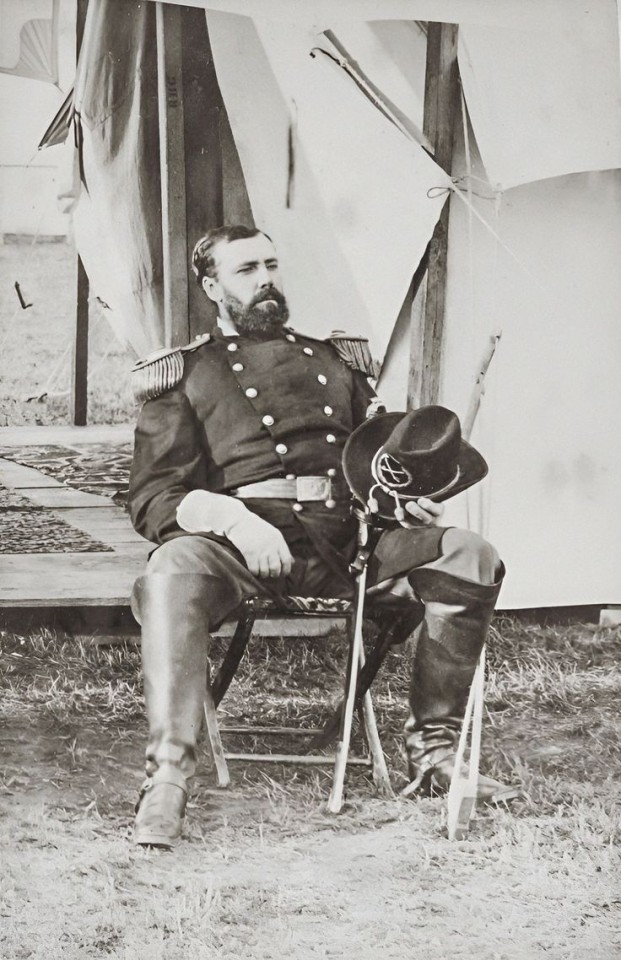
21 notes
·
View notes
Note
i hope your brother isnt as obsessed with star wars as mine is, his whole room is covered in the merch and stuff he always goes on and on about it its so annoying
Oh my G-d, mine is into all of this, like... It's not nerd shit, because some nerd shit is actually cool, like anime and stuff.
But like he's into just the dweebiest bullshit.
Like he has this game where he paints an entire army of little guys in armor with huge guns, and some of the guys are green and have fangs or something?
Like come on, dude, you're already a hardcore Pokemon competitive battler. You don't need to compete to have the lamest hobbies in the world.
I guess my dad would probably beat him, though, because at least his lame plastic models are sometimes tanks or whatever.
Imagine painting little models, but they aren't even space guys or whatever. They're like friggin Civil War soldiers.
Like if you're gonna do something art-related, at least have it be creative, right?
#ari is not an objective source on how weird or non-weird painting models is#ari class of 09#class of 09#rp ask blog#co09 ari#class of 09 ari#co09#class of 09 game#co09 rp accounts#class of '09#warhammer 40k#civil war battles
3 notes
·
View notes
Text
My surprise at this Civil War battlefield
I had no idea the surprise I would find about my family history that day. Driving from the Outer Banks to Raleigh, North Carolina. We approached a sign saying, “Bentonville Battlefield State Historic Site, next exit.”
Bentonville Battlefield, North Carolina I had no idea the surprise I would find about my family history that day. It was a nice summer’s day, we were driving from the Outer Banks to Raleigh, North Carolina. We approached a sign saying, “Bentonville Battlefield State Historic Site, next exit.” Having some extra time before our airplane took off, we took the exit onto the country road to see the…

View On WordPress
#American Civil War#Civil War#Civil War Battle#Civil War Battlefield#Civil War Battles#civil war documentary#Civil War History#United States Civil War
0 notes
Text
16 दिसंबर, संघर्ष में डूबी हुई क्रूरता: नैशविले की लड़ाई (1864)
Written By Shafeek Ahmad, Published On 16-December-2023. अमेरिकी गृहयुद्ध के दौरान दिसंबर 1864 में लड़ी गई नैशविले की लड़ाई, राष्ट्र को आकार देने वाले उथल-पुथल भरे संघर्षों के प्रमाण के रूप में खड़ी है। यह विस्तृत अन्वेषण इस महत्वपूर्ण संलग्नता की ओर ले जाने वाली घटनाओं, संघ और संघ दोनों सेनाओं द्वारा अपनाई गई रणनीतियों और युद्ध के प्रक्षेप पथ पर इसके स्थायी प्रभाव पर प्रकाश डालता…
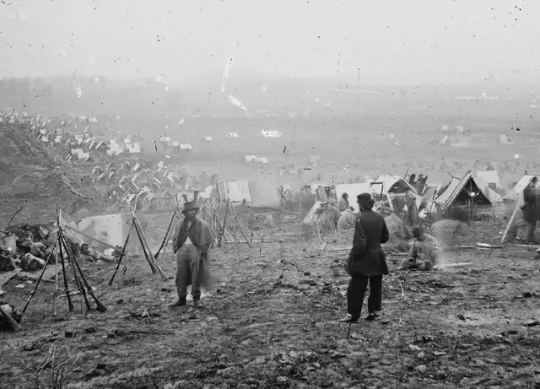
View On WordPress
#16 December special#American Civil War#Battle of Nashville#Civil War Battles#Decisive Conflicts#General John Bell Hood#Historical Narratives#Major General George H. Thomas#Nashville Fortress#Union vs. Confederate#War Chronicles
0 notes
Text
when you first start the cousland origin, you can have some conversations with arl howe, teyrn cousland, and duncan that shed some interesting light on the political situation in ferelden. it’s definitely the origin where you get the most context on the rebellion and on cailan and his father. while howe isn’t exactly the most trustworthy of sources, he is also one of the most openly critical of cailan that we have access to, which i think is worthy of interest
howe remembers maric with what the toolset describes as “genuine fondness”: “your father hasn’t spoken of our time with him? that man took care of his friends. as they say, he was large as life and twice as tall!” i think we should pay particular attention to that man took care of his friends.
what howe’s talking about is a really important aspect of kingship, where you win the consent and enthusiasm of the nobility for your rule by offering rewards like wealth, land, and prestige to the loyal. kingship is always less stable than it’s portrayed, and this is one of the ways that kings must essentially sell to the nobility that answering to them is worth their time, which would be especially important in ferelden given everything we know about its culture. fereldans believe someone only has power when it is given by the loyalty of those below them, who have the right to freely rescind that loyalty. the dao codex says that “the sight of [fereldan kings] asking for—and working to win—the support of ‘lesser’ men is a source of constant wonder to foreign ambassadors.”
i suspect howe is remembering a maric fresh from the victories of the rebellion, who was able to reward those who had followed him with the spoils of those victories. at the end of the stolen throne, we see that in the final days of the rebellion, maric was killing those who had betrayed his mother to the orlesians even when they arrived under truce to meet him on holy ground. in dao, we see no lingering orlesian nobility except for those who married in and continue to be met with marked hostility. i think we can safely surmise that maric elected to make no conciliatory measures and give everything to those who had followed him; with the orlesians on the run and his people out for blood, he was in a strong enough position to do so, and it certainly served to win the fond memories of men like howe.
by contrast, howe goes on to say, “it’s too bad cailan isn’t half that.” the toolset notes establish very clearly that it’s the same issue, elaborating on howe’s thoughts: “bitter turn, i don’t get as much from the current king”, and “disdainful, i have no use for him, he does me no favours”. this isn’t a minor character detail, if howe’s last words when killed by the player are anything to go by. “maker spit on you... i deserved... more...” whatever it is that howe feels he should have been given, by the crown or anyone else, it characterises his actions and his defining treachery.
it’s in these same conversations that we see another side of this demonstrated. there are two points where howe can openly criticise the king, and bryce immediately admonishes him for both. one even has the toolset note: “speaks sharply, as a lord to a lesser man, not a friend to an equal”. it definitely comes across that way; the way he tells howe “that’s enough” is not far off the voice he uses when the player, his child, displeases him. bryce can’t tolerate any criticism of cailan, as the couslands in dao are ardent supporters of the king. to venture some hc, i suspect that this is not merely royalist fervour, and that howe’s resentment for having been given less is matched by bryce’s awareness of the precariousness of having more.
over the centuries, the theirins have consolidated their power and eradicated almost all the teyrns (the noble rank that is second only to the king). with the only other lingering teyrn being loghain, who is essentially part and parcel of the royal family, the couslands stand alone as the only real rivals to theirin power within ferelden. there are rumours that bryce was once considered for king instead of the theirins; he too could have decided to believe he “deserved more”. but unlike howe, and perhaps understandably given his strong position and happy growing family, he is satisfied with what he has. he will not take the risk of even the slightest challenge being made within his hall
(i expect that bryce’s satisfaction with the current situation further spurred howe’s dissatisfaction to its heights, given the complicated cousland-howe history and the fact that he was expected to accept a friend he had fought beside as a superior for the rest of his life.)
i don’t think howe’s judgement on cailan is likely to be without basis. we don’t hear about any victories the young king has to his name, from which he could have passed around spoils. (to be fair, cailan had harder luck than maric in this regard. a king who raises a successful rebellion gets to bring glory and prestige to everyone who follows him, whereas a king trying to rebuild after that rebellion mostly gets to bring, uh, taxes probably. especially on wealthy centres of trade like howe’s amaranthine, one might assume.) cailan also takes a far more diplomatic approach to the question of orlais, which perhaps predictably did not win over many nobles of howe’s generation. it makes sense that cailan’s strongest supporters would instead be men like bryce who hope for things to simply continue, peacefully, as they are. perhaps in another world where cailan had won the battle of ostagar, he might have earned wider respect. (you could actually argue on this basis that there’s more sense and purpose to cailan’s glory-seeking than he usually gets credit for.) but howe already acts before ostagar, which can only demonstrate his certainty in cailan’s failings at this point: his belief that even if cailan could win, he would not be stable enough to pursue justice for the couslands
#i dont like first naming bryce. it made sense here but feels disrespectful#anyway i think that covers most of the thoughts i have here#possibly a lot of this is surface level and obvious but i think abt this a lot so i didnt want to assume anything#you can go on to make a point here about how howe gets land and titles left and right from loghain#because loghain is a battle strategist not equipped for rule so he’s relying on maric’s tactics#and also that land is cheap to him right now (or not a thing he HAS in order to LOSE it when he gives it away)#because theyre at civil war#there’s not a lot of foresight in it is my point its just about winning this whatever it takes and howe is easy to buy now#wouldve caused a lot of problems for anora down the line in a very different timeline maybe#ANYWAY. my point is that im *not* saying all that bc im tired and this post is finished goodbye
385 notes
·
View notes
Text



Guardian of the Wild Places
WARNING: Unicorns are wild animals, and can be very dangerous. If you happen to be (un)lucky enough to encounter one, do not approach if you value your life. They are extremely territorial and protective of their home ranges, and have been known to kill seemingly without provocation those who they perceive as a threat to their charges.
This was the result of my thoughts about this post, and fucking around with @morningstarequestrian's new Wild Horse Set (part 2). Thank you SO much for feeding my fantasy horse dreams.
(extra bonus pic of another horse I made under the cut. Corrupted war unicorn coming soon-ish, I hope.)

#ts4#the sims 4#ts4 screenshots#sims 4 screenshots#ts4 fantasy#sims 4 fantasy#ts4 horses#sims 4 horses#unicorns#fantasy horses#I want to make an edit using some poses I saw around simblreen-ish but we'll see if I can make it work.#mmmm. Imagine hunting a unicorn the way you would a boar. He's the most dangerous animal in the forest and if you want to live you'll treat#him that way.#or better yet stay out of his forest.#both he and the forest have been here longer than you can possibly imagine.#the horse under the cut is just pretty. I made her a fairy to ride her but I didn't really love the pics I took of the fairy.#I love the idea of unicorns as dangerous and deadly and forces of nature.#Like a bear I suppose. If you leave them alone they'll leave you alone. But if they feel threatened... good fucking luck to you.#I'll share some unicorn lore when I post the war unicorn though. Because I have some THOUGHTS about it.#like... a wild animal (THE truly wild animal) captured and tormented and bred for battle in service of civilization and industry.#Two things antithetical to their very existence... And the brutality and tragedy of what it would take to make them get that way...
90 notes
·
View notes
Text
On July 2, 1863, Colonel Joshua Chamberlain lead his men of the 20th Maine on a bayonet charge down the slopes of little round top, during the battle of Gettysburg. He would later be awarded the Medal of Honor for his actions that day.
This clip, from the movie Gettysburg, depicts the epic moment in history. It's one of the best, if not the best scene in the movie.
#gettysburg#battle of gettysburg#movies#video#civil war#army of the patomac#confederate army#little round top#joshua chamberlain#military#history#jeff daniels
161 notes
·
View notes
Text

The Death of Richard III at the Battle of Bosworth by Justo Jimeno Bazaga
#richard iii#death#battle of bosworth#battle of bosworth field#wars of the roses#art#plantagenets#plantagenet#king#england#english#house of york#history#medieval#middle ages#armour#knights#justo jimeno bazaga#europe#battlefield#civil war
131 notes
·
View notes
Text

I'm a 10 but I just found this while packing up my apartment 🤣
#it was hidden in a giant civil war battle atlas#is this what they're calling an ick?#I study civil war memory just for context#american civil war#he moves
83 notes
·
View notes
Text
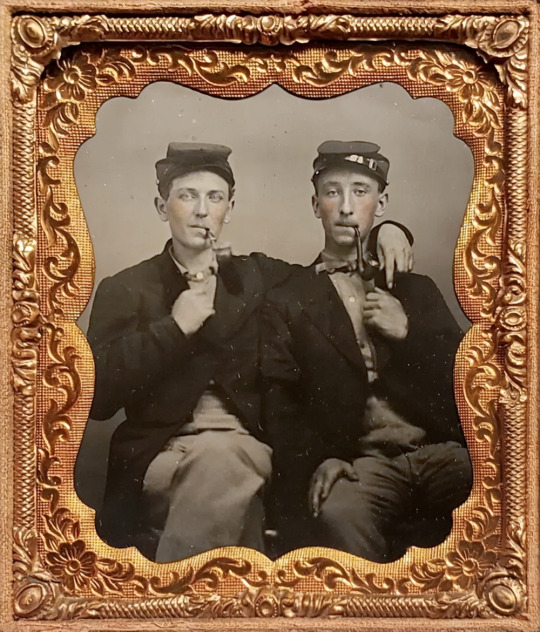
Ambrotype of a pipe-puffing pair of comrades in arms, c. 1861-65
#a smoke break between battles#ETA: on closer examination I'm uncertain if these are soldiers; the hats are kepis but those don't look like uniform jackets#american civil war#19th century#1800s#1860s#1860s fashion#19th century fashion#historical fashion#fashion history#uniforms#militaria#vintage men#19th century men#historical photography#ambrotype#retouched for tumblr please refer solely to seller's pic if purchasing
63 notes
·
View notes
Text
Union Army Colonel James Schoonmaker received the Medal of Honor for gallantry when he led a cavalry charge against Confederate artillery, driving them back and capturing many prisoners during the Third Battle of Winchester on September 19, 1864. Fought near Winchester, Virginia, it was one of the largest and bloodiest battles fought for control of the Shenandoah Valley, and was a victory for Union forces under the command of Major General Philip Sheridan.

20 notes
·
View notes
Text

Incom Corporation T-65C-A2 X-Wing Space Superiority Fighter
Source: The Star Wars Sourcebook (West End Games, 1987)
#star wars#starfighters#rebel alliance starfighters#incom#incom t-65c-a2#t-65-ca2#x-wing#x-wing space superiority fighter#rebel alliance#galactic civil war#luke skywalker#battle of yavin#first appearance a new hope#star wars sourcebook#star wars ttrpg#star wars d6#west end games#vehicles#4l4 fusial thrust engine
25 notes
·
View notes
Text

Gettysburg (Avalon Hill, 1958) is considered the first wargame to depict an historic battle. It was released in advance of the centennial of the bloodiest engagement of the American Civil War, fought July 1-3, 1863. Designer Charles S. Roberts acknowledged the game had some flawed mechanics and balance issues due to a lack of playtesting but it remained in print for many years, with a 2nd edition in 1961, a 3rd ed in 1964, and later printings through the 1970s and 80s. Attempts to fix the movement rules resulted in different editions of the game switching back and forth between a square grid and hexes on the board.
Suggested improvements to the game included those offered in The General V1 N5, January 1965, by Staff Sergeant Lou Zocchi (later a published game designer himself and the founder of dice company Gamescience):

#Gettysburg#Avalon Hill#board game#wargame#Charles S Roberts#Lou Zocchi#The General#ACW#historical wargaming#American Civil War#US history#gaming history#Battle of Gettysburg#The Battle of Gettysburg
60 notes
·
View notes
Text








Milestone Monday
On this day, November 25, 1863, the Battle of Missionary Ridge occurred. During this military engagement, Union troops, led by General Ulysses S. Grant (1822-1885), defeated the Confederate forces commanded by General Braxton Bragg (1817-1876) at Missionary Ridge in Tennessee, successfully concluding the Siege of Chattanooga.
The outcome of the Battle of Missionary Ridge had major implications for the Confederate Army. It exposed vulnerabilities in their defensive strategies and highlighted the challenges of commanding a dispersed and demoralized force. In the aftermath of the defeat, General Braxton Bragg faced intense criticism from both his troops and Confederate leadership, which eventually contributed to his reassignment.
The success at Missionary Ridge marked a key turning point in the Civil War. It secured control of Chattanooga and opened up the Deep South for subsequent Union offensives. This triumph set the stage for General Sherman's Atlanta Campaign and his infamous March to the Sea. It also reinforced the Union's commitment to prevail against Confederate forces until the war's conclusion in 1865.
The success of Union forces during this battle underscored the importance of strong leadership and coordination among troops. General Ulysses S. Grant, known for his aggressive and strategic military tactics, was later appointed commander of all Union armies and played a pivotal role in the war's conclusion. He would later become the 18th president of the United States.
Today, Missionary Ridge is preserved as part of the Chickamauga and Chattanooga National Military Park, where visitors can learn about the battle strategies, the soldiers' experiences, and the broader context of the Civil War.
The images come from the following books in our Civil War Collections:
Lee and His Generals by Capt. William P. Snow, published in New York by Richardson & Company in 1867.
Braxton Bragg, General of the Confederacy by Don C. Seitz, published in Columbia, S.C. by The State Company in 1924.
The Generalship of Ulysses S. Grant by Colonel J. F. C. Fuller, published in New York by Dodd, Mead and Company in 1929.
Personal Memoirs of U. S. Grant published in New York by C. L. Webster in 1885.
Life and Public Services of General Grant Being a Complete Life of the Great Hero Following His Career from the Cradle to its Close ... by William Ralston Balch, published in Chicago by J.S. Goodman in 1885.
View more of our Milestone Monday posts
-Melissa, Special Collections Graduate Intern
#Milestone Monday#milestones#history#civil war#Battle of Missionary Ridge#war generals#ulysses s grant#braxton bragg#on this day#Missionary Ridge#chattanooga#war battles#memoirs
22 notes
·
View notes
Text
Okay but......... imagine if Luke reincarnates as a demigod child of Nemesis.
And he actually has a fairly decent home life and manages to get to camp safely.
So suddenly Annabeth is confronted with a child with hauntingly familiar eyes, a strong sense for justice-
-and also an abnormal interest in anything concerning revolts or revolutions against unjust systems.
#pjo#luke castellan#luke castellan apologist#pro luke castellan#pjo fandom#reincarnated luke castellan#for a hot second everyone thinks he's an Athena kid when he rambles on about the logistics of the bolshevik revolution#and the following civil war in russia#until people realize the intrest is less “yay battle strategy!” and more “yay revolution!”#he's a history nerd going manic over his history books#u notice the adhd when u ask him about the french revolution#annabeth chase
42 notes
·
View notes